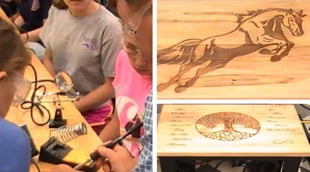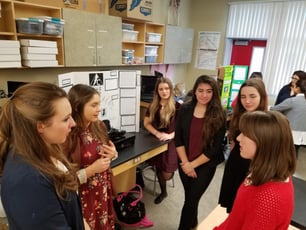During 17-year-old Emily Moore’s sophomore year of high school, her father proposed something she’d never considered: taking an Introduction to Engineering class through her high school’s Project Lead The Way program. As an engineer himself, Moore’s father wanted her to explore her options, but Moore wasn’t so sure.
“When my dad told me I had to take a class, I was really against the idea. I thought, “Ugh, only boys take those classes. But then I heard they were going to have an all-girls class this year. That got me more excited,” she says.
It seems that Moore’s dad and Hilliard Davidson High School Engineering teacher, Bill Kuch, were thinking along the same lines. In his third year of teaching Project Lead The Way (PLTW) engineering courses outside of Columbus, Ohio, Kuch was noticing what he considered to be a problem. Out of the 80 students in his four engineering classes, only eight were female.
Gender diversity is a nationwide concern that universities, corporations, and even the U.S. Department of Commerce and The President have been researching for years. According to a 2011 report from the U.S. Department of Commerce, while women represent 48 percent of the overall workforce, they represent only 24 percent of the workers in Science, Technology, Engineering, and Math (STEM) fields, and only 13 percent of engineers. It is currently estimated that 6.7 million men have STEM degrees, compared to just 2.5 million women. And for women who do earn degrees in STEM-related fields, it is more likely that their career paths will diverge into healthcare or education occupations than actual STEM occupations.
But how to get more girls in the seats of his engineering classroom was what Kuch needed to figure out.
“The girls who were in the classes were incredibly successful and were staying in the program,” Kuch says. “So we started brainstorming and thought, ‘What if we had an all-female Introduction to Engineering Design course?’”
Kuch discovered that The Ohio State University has a Women in Engineering department to mentor the female engineering majors. OSU’s Women in Engineering (OSU WiE) faculty agreed to partner with Kuch to create Hilliard Davidson’s own Women in Engineering (WiE) program, replicating some of OSU WiE’s female outreach efforts: inviting female engineers to speak to the class and act as mentors to the students, and recruiting girls to engineering before they enter high school. Hilliard’s WiE program, coupled with the all-girls section of Introduction to Engineering Design (IED), has resulted in the enrollment of an additional 18 girls this school year, with 30 new students already enrolled for next year.
Now, near the end of her first year of engineering, Moore says it’s changed her career goals.
“I always thought I’d go to OSU and become a math teacher. But this has opened my eyes. Electronics—it’s usually a boy thing, like video games, cars, taking things apart, and building things—but it’s actually all really cool.”
She’s enrolled in two engineering classes next year and she still plans to go to OSU after graduation…to study engineering.
The success at Hilliard Davidson is being replicated throughout the country as middle and high schools attempt to bring more girls into their PLTW engineering programs.
• Gulliver Academy Middle School, Coral Gables, Fla.: Before opening two all-girls sections of engineering classes, engineering teacher Yolanda Baquet only had eight girls in all six of her engineering classes combined. One year later, after adding two sections reserved only for girls, Baquet now has 25 girls in the two classes and a waiting list. The girls are thriving and teaching Baquet along the way. The projects the girls are most interested in center around inventing things that change the quality of life for women, projects that relate to their everyday lives, and understanding the historical significance of their inventions. Baquet cites one specific project where the girls were challenged with building solar ovens. The girls learned that in many African tribes, women and children who spent their days searching for firewood were raped and were victims of violence. When a national relief organization began donating solar ovens to the tribes, the rape and violence decreased. The girls are realizing how important engineers are for improving people’s lives, Baquet says.
• Ann Richards School for Young Women Leaders, Austin, Tex.: STEM is the focus of the curriculum at the Ann Richards School for Young Women Leaders. Founded in 2007 with the goal that 100 percent of students graduate and attend college, the school is an all-girls public high school serving 600 girls in grades six through 11. It will expand to 12th grade in the fall. The demographics of the Ann Richards School mirror the local community and the groups among which engineers are greatly underrepresented: 61 percent of the students are Hispanic, 22 percent Caucasian, 13 percent African-American, three percent Asian-American, and one percent American Indian/Alaskan Native.
• SWEET: Society of Women Exploring Engineering and Technology, Jefferson High School, Cedar Rapids, Iowa: This group of girls at Thomas Jefferson High School is spreading their passion for engineering across the entire state. Teacher Lisa Digman, a Project Lead The Way Master Teacher, started SWEET this year to keep the girls who were already studying engineering engaged and exposed to the power of women in the engineering profession. Realizing there wasn’t an organization dedicated to high school girls in engineering, Digman started her own. The group of girls recently traveled to General Mills, where they were mentored for the day by General Mills’ young female engineers. The SWEET girls are doing mentoring of their own, too. “My girls didn’t really have anyone championing them to get into engineering,” Digman says. “So they have made a big effort to reach backward into the fifth, sixth, and seventh grades to introduce engineering to the younger girls and show them that engineering is fun.”
After attending the state’s legislative event last week, Digman says teachers and administrators at schools from Iowa City to Cedar Rapids inquired about expanding SWEET, wanting to connect their students to hers.
The success of these schools in recruiting girls to engineering is only a small sample of what schools across the United States, particularly schools with Project Lead The Way’s STEM curriculum, are doing to help change the country’s engineering demographics. The work being done in these classrooms is important to the overall success of the U.S. economy. It is estimated that by 2020, just eight years from now, the labor market will be out of balance. Seventy-four percent of all jobs will be the high-pay, high-skill STEM-related jobs, with 123 million people needed. Only 50 million Americans are expected to be qualified for the available jobs.
For 17-year-old Emily Moore, she’s grateful to have been introduced to her future career. Being part of the movement that’s smashing the stereotypes that women don’t belong in engineering is pretty cool too, she says. “Taking things apart and building new things is really cool. I like to make things that are real life. I like to put it on a computer with our design software and have it be there in 3-D, ready for me to make it a reality.”

